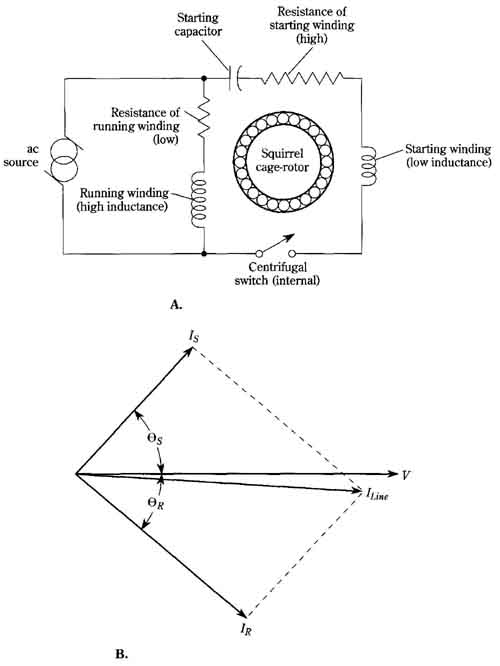AMAZON multi-meters discounts AMAZON oscilloscope discounts
.The split-phase motors just described use the resistive and inductive components of two windings to simulate a two-phase rotating field inside the stator. The simulation is actually not very good because it’s impractical to produce predominantly inductance in one winding and predominantly resistance in the other. The insertion of external resistance in the starting winding helps this situation, but at the expense of efficiency and convenience. A much better approach is to associate a capacitor with the running winding. It’s known that resistance-capacitance circuits more readily approach a 90-degree phase shift than resistance-inductance circuits do. The practical capacitor is a much “purer” reactance than the practical inductor, whether the latter is an inductive component or a motor winding.
It so happens that an appropriate capacitor associated with the starting winding of a resistance-start, split-phase motor converts the machine to a capacitor motor. The two-phase rotating field developed in the stator of the capacitor motor is much more symmetrical than the rather “lopsided” one produced in the resistance-start, split-phase motor. The addition of the capacitor results in a quieter running motor with a much greater starting torque. The equivalent circuit and the phase relation ships in this motor are shown in FIG. 9 (below).
-- --

FIG. 9 The capacitor-start, split-phase motor. A. Equivalent circuit. AC source;
Resistance of starting winding (high); Starting capacitor; Centrifugal switch
(internal). B. Initial phase relationships during starting interval.
- - -
The capacitor-start, split-phase motor is much easier to reverse than the resistance-start type is. To accomplish reversal, the motor is temporarily disconnected. As soon as the speed drops so that about 20 percent slip exists, the centrifugal switch will close its contacts. If, after this occurrence, the motor is re-energized with its starting winding transposed, deceleration and subsequent acceleration in the opposite direction will take place.
The salient features of the capacitor-start motor is its inordinately high starting torque as compared with other “artificial-start” induction motors. Starting torques from three to five times the rated torque are typically found in these motors.